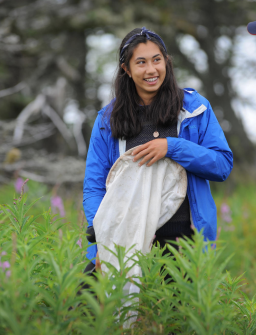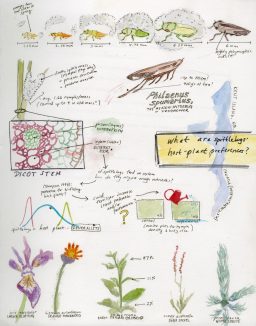Beneath the Foam: Spittlebugs’ Preferred Host Plants
By Rebecca GoldfineThe honors thesis of Zoe Wood ’18 is one of four projects we’re highlighting to show the breadth and depth of undergraduate research this year.

Many of the biology students arrive at the Bowdoin Scientific Station on Kent Island and look up — opting to do research on the birds of the island, and taking advantage of longterm data that’s been collected on several species that breed there.
Zoe Wood ’18, however, opted to keep her eyes on the ground — looking for the distinctive marker of the spittlebug. A focus on the spittlebug was a less common research path, which allowed her to discover some interesting new findings about this common insect, and other insects with similar survival strategies.
Wood’s honors project, which looked at the host-plant preferences of meadow spittlebugs, was the “first study conducted on spittlebug ecology and natural history on Kent Island, which was exciting and came with joys and challenges,” she said recently. Spittlebugs are common on the island and around the world, and in some areas their nymphs are considered an agricultural pest as they like to feed on hay and alfalfa.
Most people know spittlebugs for the unique white foam that their nymphs produce, which looks remarkably similar to a gob of human spit. This mass is a byproduct of the insects sucking on the plant’s xylem, which carries water up through the plant. The spittle also protects the nymphs from drying out and offers a sort of shelter from hungry predators.
“I am broadly interested in plant-insect interactions,” said Wood, who is considering pursuing a career in entomology. Wood sees the small size of insects as a plus. “I really like being able to see things, tinker with them, and look at them closely.” Researching insects has a few other benefits, too. “You don’t need [research] permits [as you do with other animal or human subjects], and you can get a great sample size with insects.”
She concluded: “They’re under-appreciated and amazing. After all, after humans, ants runs this world.” This summer, she’ll be studying Chinese praying mantises at a field station in western Pennsylvania. “I’d love to work with Lepidoptera, ants, bees — those big-name insects,” she said.
For her honors research, Wood pursued two lines of investigation: she looked into which plants the insects prefer, and how much plant choice matters. She examined whether laying eggs on particular plants improves the success of nymphs, and whether fertilizing plants affects nymphal development.

Patty Jones, an assistant professor of biology and Wood’s advisor, said she and Wood are submitting Wood’s thesis to the journal, Northeastern Naturalist. “I have been so impressed with Zoe’s hard work both in the field and while writing,” Jones said. “She came up with multiple experiments to do in the field based on her observations, and she did a great job collecting measurements.” Wood is also an accomplished artist, she added, and the senior recently received the biology department’s Copeland-Gross prize for best senior biology major who embraces the liberal arts mentality.
To collect data, Wood scoured the island’s meadows last summer for the telltale globs, noting where she found nymphs and counting how many she found on each plant. She also measured the nymphs’ body sizes. Spittlebugs are unusual in that they are one of the few insects who feed on more than three plant families. Most other insects specialize. One contribution of Wood’s research is a better understanding of how the “generalist” strategy works for insects.
In total, Wood discovered spittlebug nymphs on thirty-one different species. But it became clear to her, based on the density of nymphs she found on the plants, that they preferred Canada thistle and goldenrod. She hypothesized initially that this preference might correlate to healthier nymphs—i.e., they might develop faster and be larger. But her data indicated that this was not the case, and she surmised that mother spittlebugs might prefer laying eggs on thistle because it offers a natural prickly protection against predators. And goldenrod, according to Wood, “essentially dominates meadows and open areas on Kent Island, as it grows well in disturbed areas. It is likely the most abundant perennial on the island, and also is available in the early spring, when spittlebug nymphs first hatch — so it makes sense that nymphs would be found in high densities.”
Wood did find that fertilized, and thus more robust, goldenrod plants affect nymphal development. After fertilizing a patch of goldenrods to compare to an untreated control plot, she found faster-growing nymphs on the fertilized plants. “Nymphs that become adults sooner can mate sooner and could affect population structure and genetics,” she said.
Knowing which plants that spittlebug mothers prefer (and, subsequently, their nymphs also prefer) could also help farmers defend against them, she suggested, because farmers could plant rows of more appealing crops in between the crops they want to protect. “Knowing spittlebug preferences can help people develop more natural solutions rather than relying on chemical fertilizers,” she said.



